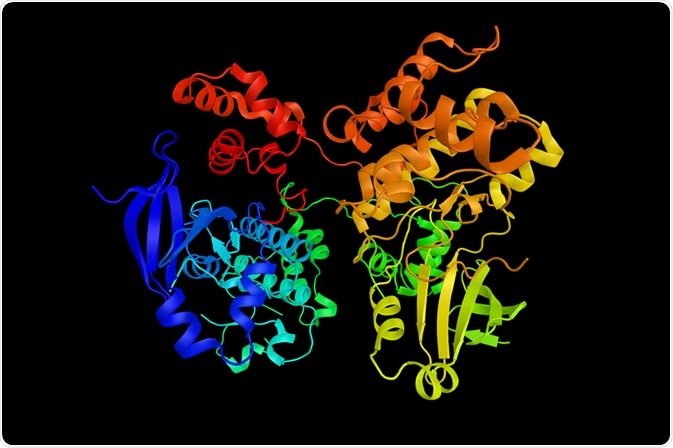The phosphorylation of proteins represents the basis of numerous cellular processes, as well as many pathological conditions like cancer and even the novel coronavirus severe-acute-respiratory syndrome coronavirus 2 (SARS-CoV-2).
 Image Credit: ibreakstock/Shutterstock.com
Image Credit: ibreakstock/Shutterstock.com
What is a post-translational modification (PTM)?
The post-translational modification (PTM) of proteins is crucial to a wide range of biological processes, some of which involve structure regulation, protein localization, and signal responses, that occur within the cell.
Some of the most widely studied PTMs include phosphorylation, acetylation, glycosylation, methylation, ubiquitylation, sumoylation, and myristoylation, to name a few.
PTMs, which typically occur later on in the protein biosynthesis process after DNA has been transcribed to RNA and translated into proteins, can be reversible or irreversible.
To date, over 40 PTMs and 140 different residues have been identifying, thereby representing the role that PTMs have in expanding the functional diversity of proteins to ultimately create the highly complex proteome of biological organisms.
What is protein phosphorylation?
As one of the most common and important PTMs, the phosphorylation of proteins is critical to numerous physiological processes that regulate the cardiovascular, gastrointestinal, and immune systems, as well as the mechanisms, behavior, and actions of the neurological, musculoskeletal and endocrine systems.
In addition to these normal organ functions, protein phosphorylation can also contribute to various pathological conditions, such as cancer. Studies have shown that over 60% of the 21,000 proteins encoded by the human genome can undergo phosphorylation.
What are kinases?
The PTM of phosphorylation is a reversible process that is entirely dependent upon the action of protein kinases (PTKs). The 568 PTKs of the human genome participate in phosphorylation by adding a phosphate group (PO4) to the polar R group of several different types of amino acids. It is estimated that over 30% of all protein phosphorylation events occur on serine (Ser), threonine (Thr) and tyrosine (Tyr).
Although phosphorylation of histidine (His) and aspartate (Asp) residues can also occur, these conformation changes are often the least stable compared to the aforementioned processes. Note that PTKs are often classified according to the specific amino acid residue in which these enzymes phosphorylate.
The addition of a phosphate group at this location causes the previously hydrophobic apolar protein to now become hydrophilic and polar. Serine/threonine kinases (STKs), for example, phosphorylate the hydroxyl (OH) group of either the Ser or Thr group after a specific event occurs, such as DNA damage.
Once phosphorylated, the protein can undergo a conformational change following its interaction with other molecules. More specifically, phosphorylated amino acids can bind molecules that can subsequently interact with other proteins, thereby resulting in the assembly or detachment of various protein complexes.
Protein phosphatases
As compared to PTKs, protein phosphatases have the opposite function and remove the phosphate group from previously phosphorylated proteins. The phosphatase reaction occurs through the hydrolysis of phosphoric acid monoesters, which results in the separation of the phosphate group from a protein molecule that now has a free hydroxyl group.
Typically, the 226 known protein phosphatases of the human genome act as ‘housekeeping enzymes.’
Protein phosphorylation and cancer
Recent advances have elucidated the various ways in which PTKs can be implicated in carcinogenesis and the metastasis of several different types of cancers. Since PTKs reform a wide range of overlapping roles in cell transformation, tumor initiation, survival, and proliferation, these enzymes are often categorized by their hallmark roles in cancer.
One group of PTKs that are associated with cancer include those that are directly involved in primary oncogenes transformation, particularly cytoplasmic tyrosine kinases and the PI3K family of dual specific protein/lipid kinases.
The PI3KCA kinase, for example, catalyzes the production of a phospholipid known as PIP3, which has downstream effects that can promote the growth and survival of tumor cells. Another group of oncogenic kinases includes those that are present downstream of tumor initiation, such as EGFR. EGFR, which is a receptor tyrosine kinase, can maintain intracellular glucose levels that prevent autophagic cell death of tumor cells.
Despite their contributions to cancer growth and metastasis, several novel small-molecule inhibitors have been developed to specifically target kinases and reduce tumor burden in patients.
.jpg)
Image Credit: Kateryna Kon/Shutterstock.com
Protein phosphorylation and SARS-CoV-2
To determine how different cellular pathways and processes respond to infection by the novel severe acute respiratory syndrome coronavirus 2 (SARS-CoV-2), a group of researchers analyzed a quantitative survey of the global phosphorylation a protein abundance landscape of infected samples.
This mass spectrometry (MS)-based approach found that infection by SARS-CoV-2 promoted the activation of both casein kinase II (CK2) and p38 MAPK, as well as the production of various cytokines and mitosis kinases.
From this information, the researchers identified 87 drugs that resembled the global phosphorylation profiles of the virus.
Taken together, the connection made between protein phosphorylation and infection by SARS-CoV-2 provided a new insight into potential therapies.
References
- Ardito, F., Giuliani, M., Perone, D., Trojans, G., & Muzio, L. L. (2017). The crucial role of protein phosphorylation in cell signaling and its use as targeted therapy. International Journal of Molecular Medicine 40(2); 271-280. doi:10.3892/ijmm.2017.3036.
- Marin-Garcia, J. (2014). Chapter 2 – Methodologies in the Era of Cardiovascular “Omics.” In: Post-Genomic Cardiology 2nd edition. doi:10.1016/B978-012-404599-6.00002-2.
- Tarantino, M. K., & Cole, P. A. (2009). The Chemical Biology of Protein Phosphorylation. Annual Review of Biochemistry 78; 797-825. doi:10.1146/annurev.biochem.78..070907.103047.
- Bullard, K. S., Lagaron, N. O., McGowan, E. M., Parmar, I., et al. (2018). Kinase-targeted cancer therapies: progress, challenges, and future directions. Molecular Cancer 17(48). doi:10.1186/s12943-018-0804-2.
- Bouhaddou, M., Memon, D., Meyer, B., White, K. M., Rezelj, V., et al. (2020). The Global Phosphorylation Landscape of SARS-CoV-2 Infection. Cell. doi:10.1016/j.cell.2020.06.034.
Further Reading